Reichsmarschall
Reichsmarschall of the Greater German Reich (German: Reichsmarschall des Großdeutschen Reiches) was the highest military rank (comparable to Generalisimo) in the Wehrmacht (Heer, Luftwaffe, and Kriegsmarine) of Nazi Germany during World War II.[1]
| Reichsmarschall | |
|---|---|
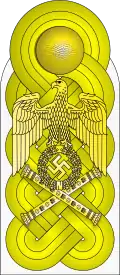 Shoulder boards | |
| Country | |
| Rank | Six-star (unofficial) |
| NATO rank code | OF-11 |
| Non-NATO rank | O-12 |
| Formation | 12th century (historical) 19 July 1940 |
| Abolished | 1945 |
| Next higher rank | None |
| Next lower rank | Generalfeldmarschall Großadmiral |
History

Until 1940 the highest rank in the German military was Generalfeldmarschall (General field marshal). At the beginning of World War II, the only active holder of that rank was Hermann Göring, Commander-in-Chief of the Luftwaffe. On 19 July 1940, after winning the Battle of France, Hitler promoted twelve generals to the rank of Generalfeldmarschall. During the same ceremony, Göring was promoted to the newly-created rank of Reichsmarschall to placate his thirst for prestige[2][3] and to highlight his position as senior to the other Wehrmacht commanders, without giving him any actual authority over them.
Göring was also designated as Hitler's successor. Nevertheless, on 23 April 1945, when Göring suggested to Hitler that he assume leadership of the crumbling Third Reich, Hitler relieved Göring of his duties and named a new successor in his last will and testament, Grand Admiral Karl Dönitz. Dönitz' appointment was made on or before the day of Hitler's suicide (30 April 1945), but notification by Martin Bormann and Joseph Goebbels was delayed until 1 May 1945.[4]
Official standards
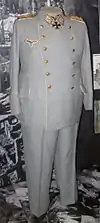
 Standard of the Reichsmarschall from 1940 to 1941 (left side)
Standard of the Reichsmarschall from 1940 to 1941 (left side)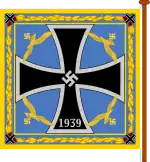 Standard of the Reichsmarschall from 1940 to 1941 (right side)
Standard of the Reichsmarschall from 1940 to 1941 (right side)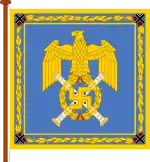 Standard of the Reichsmarschall from 1941 to 1945 (left side)
Standard of the Reichsmarschall from 1941 to 1945 (left side)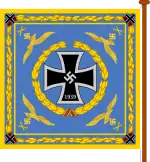 Standard of the Reichsmarschall from 1941 to 1945 (right side)
Standard of the Reichsmarschall from 1941 to 1945 (right side)
Rank insignia
 Shoulder boards
Shoulder boards Collar insignia
Collar insignia
junior rank
|
(rank Wehrmacht) Reichsmarschall |
senior rank Führer des Großdeutschen Reiches und Oberster Befehlshaber der Wehrmacht |
Citations
- Haskew 2011, p. 46.
- Göring also held many other prestigious titles, such as Reich Master Hunter and Commissioner Plenipotentiary of the Four-Year Plan
- Haskew 2011, pp. 25, 46, 119.
- O'Donnell 1979, p. 217.